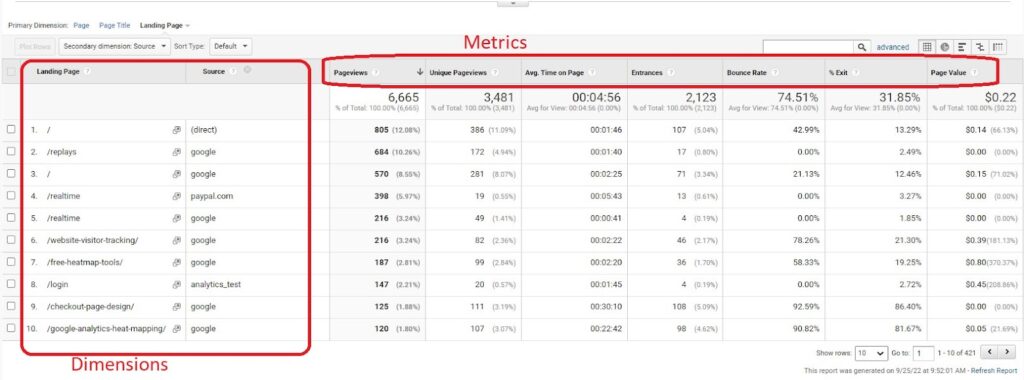Page Contents
Any Google Analytics report is made of metrics and dimensions. A metric is a quantifiable measure used to track and assess the status of a process, goal, or activity, while a dimension is the attribute of visitors to your website. To assess your website’s performance on the marketing goals, the most reliable way is to track metrics and dimensions.
Note: WatchThemLive is a Google Analytics alternative that can give you insight into your customer’s journey and conversion rate. Sign up for FREE and see for yourself!
What Is a Metric in Google Analytics?
In Google Analytics, a metric is a quantitative measurement that is used to track and report your website traffic and user behavior data. You can then use this data in order to assess your website’s performance. For example, you can understand how many times a certain page was viewed, or a video was played. Common metrics tracked in Google Analytics include pageviews, unique visitors, session duration, and bounce rate. Metrics can be customized and configured to meet the specific needs of an organization or individual.
What Is a Dimension?
A dimension is a descriptive characteristic of an object that can be valued in different ways. For instance, values for the city name dimension can be New York, Berlin, or Helsinki. Dimensions on Google Analytics can be predefined or custom. The number of predefined dimensions is more than 200.
How Is a Metric Different From a Dimension?


Metrics, unlike dimensions, are quantitative measurements of data, dimensions are the labels we use in order to describe the metrics. So, as the nature of quantitative data is, metrics are expressed by numbers, while dimensions are non-numerical values.
Common Google Analytics Metrics
As you can see in the picture above, the common Google Analytics dashboard categorizes the metrics into four groups; audience, acquisition, behavior, and conversions. Let’s dive a bit deeper into these metrics.
1. Audience
Audience category includes metrics that help you answer questions like “who is my customer?” and lets you gain information like their location, demographics, retention, and device technology.
1- Number of users: With the help of this metric, you can see the number of visitors to your website in a certain period of time.
2- Sessions: You can also see the sessions, which are the number of times that visitors actively engaged with your site. For example, one user can initiate three sessions, that’s why the number of users may be different from the number of sessions.
3- Average session duration: Refers to the average amount of time a user stays on your website in a single session.
4- Average pages per session: The average number of pages a visitor views in a single session on your site.
5- Bounce rate: Bounce rate is the percentage of visitors who entered your website and leave without initiating any sessions.
2. Acquisition
Acquisition is mainly about those metrics that are designed to answer questions like “who are my visitors?” or “how did they get here?”
The metrics listed under the acquisition category are:
1- Users: Is refered to visitors who initiated at least one session on your web page in the chosen specific range of time.
2- New users: As the term implies, it is used for the number of first-time users in a specific range of time (as opposed to returning visitors.)
3- Sessions: Google Analytics can record a session every time a person visits a website, and then it terminates the session after 30 minutes if the person has zero activity. It also tracks all the user’s interactions that happened during that time.
3. Behavior
In the behavior section, the metrics are designed to answer questions like “how did visitors behave while they were visiting?”
The metrics that are used for this part are:
1- Bounce rate: Bounce rate is referred to the percentage of all single-page sessions where the analytics server was not able to record the interactions. In other words, it is the percentage of visitors who landed and left without performing any actions or navigating to a second page.
2- Page/ Session: This metric is used to track the average number of pages a visitor viewed within a single session.
3- Session duration: The average time a visitor stays on your web page in a single session.
4- Exit rate: Exit rate is used to indicate how often visitors exit a certain page after visiting several pages on a site. The formula for calculating the exit rate percentage is:
(number of exits/number of pageviews for a particular page) x 100
4. Conversion
The conversion dashboard includes the metrics that answer “ how many people converted and how much revenue did the company get?”
1- E-commerce conversion rate: This metric shows the ratio of transactions to sessions, expressed as a percentage. In other words, it is the percentage of the whole visits a website receives that results in a conversion action.
2- Transaction: The transaction metric displays the unique orders or completed purchases on your online store.
3- Revenue: The total amount of money that was gathered from the transactions.
Metrics in Google Analytics can be incredibly useful when it comes to understanding your website’s performance. You can see who and from where is visiting your website, what device they are using, and what their priorities are. Still, Google Analytics metrics are only designed to provide you with quantitative data, metrics can tell you what is happening on your website, but they can’t tell you why your visitors behave in a certain way.
There are some Google Analytics alternative tools that can provide you with qualitative data too.
Gather Both Qualitative and Quantitative Data with a GA Alternative
WatchThemLive is a behavior analytics tool that enables you to combine the insights that Google Analytics metrics give you with the data web analytics, heat maps, session replays, and goal tracking provide you with.
Website Analytics: Website analytics is an outstanding feature that enables you to collect and analyze a website’s data. The gathered data will give you a better understanding of your target market so that eventually, you can optimize your website. Website analytics provide you with the number of visitors, page views, session length, user locations, operating system, etc.
Heatmaps: A heatmap is a powerful data analysis tool that presents the data in a visualized form. A heatmap uses different colors to display the data, and it can give you an immediate and clear insight. Heatmaps can show you which buttons and CTAs are working or are down and which ones are receiving the most and the least interactions.
Session replays: A session replay (session recording) is a video of your users’ screen while they were on your website. This amazing feature lets you see every single movement your visitors make, like their mouse movements and clicks. Watching session replays is an easy and understandable way of studying user behavior, as there is no numerical data and you can simply see what is attracting your visitors and what the drop-offs are. This is how it works:
Goal and conversion tracking: A conversion goal is the desired action you are expecting your visitors to perform on your website. It can be responding to a CTA, clicking on a link, or adding a product to your cart. Conversion tracking, on the other hand, is the process of observing the interactions your visitors have on your website and making sure they are converting. This way of monitoring will inform you of metrics that should be improved to boost revenue growth.


Can We Add Custom Metrics to Google Analytics?
The short and straight answer is yes. In addition to the metrics and dimensions that are already available on Google Analytics, you can use custom metrics to monitor and track data that Google Analytics does not track. To create a custom metric or dimension, you must have the editor role, and then: First, you need to set up the custom metrics in your property, and then you can modify your tracking code.
How to Create a Custom Metric
1- Sign in to Google Analytics.
2- Click Admin (at the bottom left of the page.)
3- Click Custom Definitions and then Custom Metrics.
4- Click on New Custom Metric.
5- Choose a name and add it.
6- From the Formating type, select an Integer, Currency, or Time.
7- Check the Active box to see the metric in your reports. Still, if you want to create the metric but have it inactive, uncheck the box.
8- Click Create and you are done.
Why Use Metrics?
Metrics provide you with objective measures of performance, and the achieved data enables you to “manage by the fact”. Metrics are used to compare and track performance or your company’s production. All in all, metrics can help you make the right decisions, drive performance, produce good internal and external public relations and finally, change and evolve with the organization.
Pro Tip: Do you want to pass Google exams? Then don’t miss these Google certification dumps!
Conclusion
In conclusion, Google Analytics metrics can be a great help for monitoring website performance as far as there is no need to track qualitative data. Google Analytics can work significantly better if you integrate it with a third-party tool. This allows you to get more detailed insights into your website’s traffic and the way users are interacting with it. However, a behavior analytics tool such as WatchThemLive can be a perfect alternative for Google Analytics, as it can track goals and user behavior, and can provide you with both quantitative and qualitative data. Sign up and seize them now!

